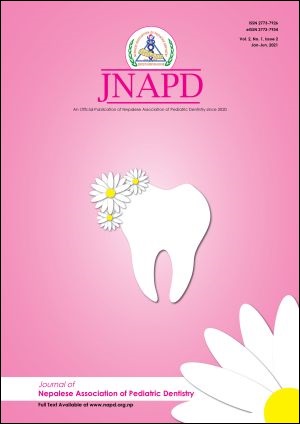Virtual Dental Care - Pediatric Teledentistry
DOI:
https://doi.org/10.3126/jnapd.v2i1.41606Keywords:
Covid-19, Pediatric dentistry, tele-dentistryAbstract
Teledentistry falls under virtual dental care where use of virtual communication is in between dentist and the patient to provide dental care and education to patients. Patients receive virtual examinations and are provided consultation, diagnosis, treatment planning, guidance, transmission of dental information and education via tele-communications. During this COVID-19 pandemic it has offered a solution to resume dental practice as a tool ensuring safety for all. Pediatric teledentistry helps by saving time, allowing child- dentist interaction before the visit and reducing stress for patients, guardians and dentists. Telescreening and teletriage can be implemented publically into routine dental practice and also as a triage-based emergency management strategy as it provides an effective compromise between limiting patient admission, ensuring their pain control and symptom relief.
Downloads
Downloads
Published
How to Cite
Issue
Section
License
Copyright (c) 2021 Subhani Vaidya, Senchhema Limbu, Manish Malla

This work is licensed under a Creative Commons Attribution 4.0 International License.
This license enables reusers to distribute, remix, adapt, and build upon the material in any medium or format, so long as attribution is given to the creator. The license allows for commercial use.




